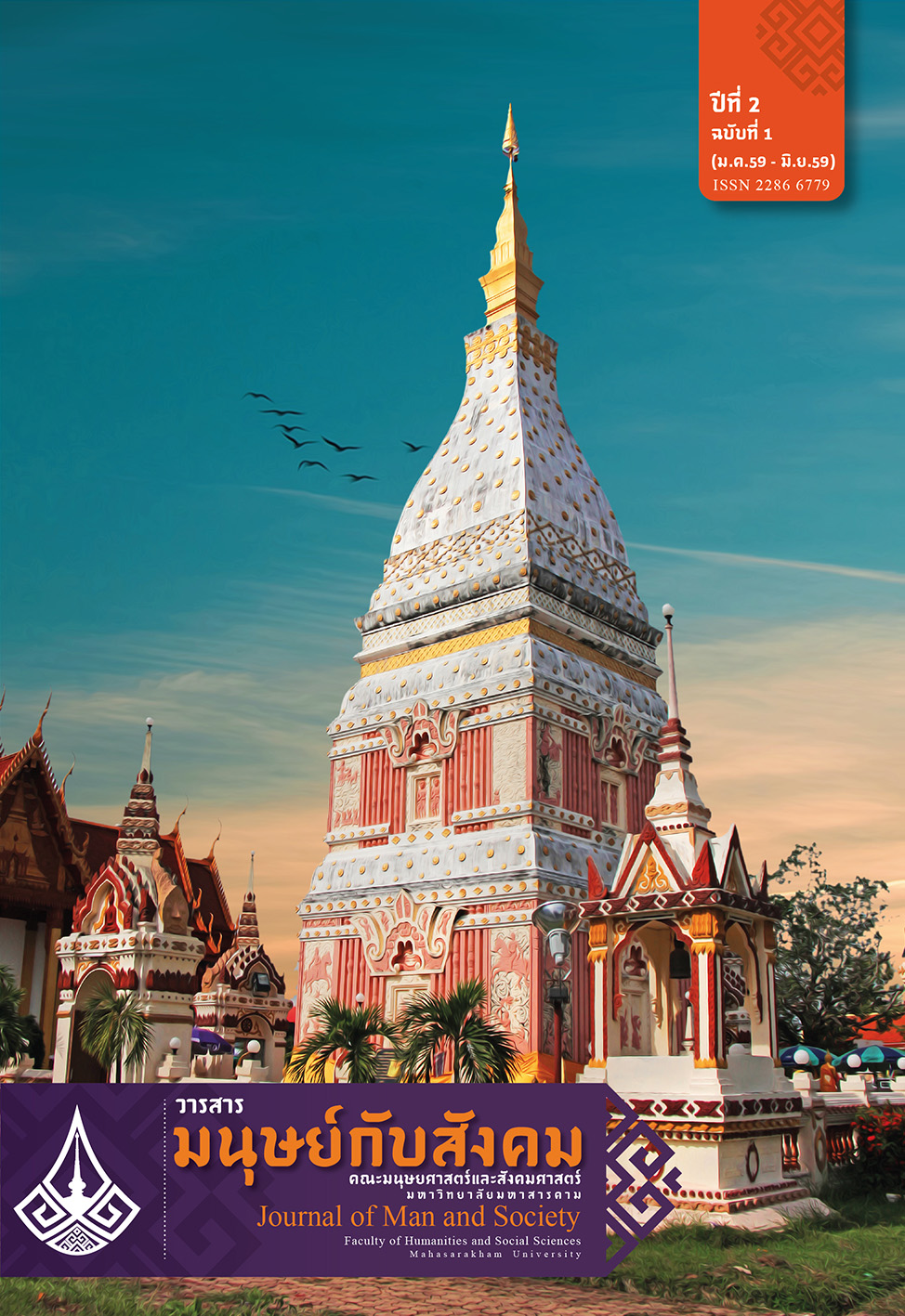Social Space Construction of the Christians in Song Khon Village, Wan Yai District, Mukdahan Province
Main Article Content
Abstract
This article aimed to study social space construction of the Roman Catholics in Song Khon Village, Wan Yai District, Mukdahan Province. Results found that social space was constructed by the narratives influenced by antecedent memories, the transformation of sacred space and fields of care to public space, the adjustment of religious beliefs and rituals as hybrid cultures. These actions have accomplished through the integration of culture and the application of beliefs and rituals for the participation of other people from all religions. All practices could encourage villagers’ representation of identity in order to receive perception, understanding and acceptance from external people. This strategy is useful for the villagers to survive and protect their dignity due to marginalization under power relations.
Article Details

This work is licensed under a Creative Commons Attribution-NonCommercial-NoDerivatives 4.0 International License.
เนื้อหาและข้อมูลที่ตีพิมพ์ลงในวารสารมนุษย์กับสังคม ถือเป็นข้อคิดเห็นและความรับผิดชอบโดยตรงของผู้เขียนซึ่งกองบรรณาธิการวารสารไม่จำเป็นต้องเห็นด้วยหรือร่วมรับผิดชอบใดๆ
บทความ ข้อมูล เนื้อหา รูปภาพ ฯลฯ ที่ได้รับการตีพิมพ์ในวารสารมนุษย์กับสังคม ถือเป็นลิขสิทธิ์ของวารสาร หากบุคคลหรือหน่วยงานใดต้องการนำทั้งหมดหรือส่วนหนึ่งส่วนใดไปเผยแพร่ต่อต้องอ้างอิงวาสาร
References
กรมโฆษณาการ. (2498). ประมวลรัฐนิยมและระเบียบวัฒนธรรมแห่งชาติ. พระนคร: พานิชศุภผล.
ขันทอง (ไม่มีนามสกุล). (22 ตุลาคม 2559). สัมภาษณ์. ราษฎร. บ้านนาแกน้อย ตำบลป่งขาม อำเภอหว้านใหญ่ จังหวัดมุกดาหาร.
จี ว่องไว. (24 กรกฎาคม 2559). สัมภาษณ์. ราษฎร. บ้านสองคอน ตำบลป่งขาม อำเภอหว้านใหญ่ จังหวัดมุกดาหาร.
ชาญวิทย์ เกษตรศิริ. (2544). ประวัติการเมืองไทย. พิมพ์ครั้งที่ 2. กรุงเทพฯ: โครงการตำราสังคมศาสตร์และมนุษยศาสตร์.
ธเนศ วงศ์ยานนาวา. (2543). อภัยวิถี: เทววิทยาทางการเมือง ความทรงจำและความหลงลืมของประวัติศาสตร์ไทย. รัฐศาสตร์สาร, 22(1), 130-183.
__________ . (2552). ความไม่หลากหลายของความหลากหลายทางวัฒนธรรม. กรุงเทพฯ: สมมติ.
นิธิ เอียวศรีวงศ์. (2551). วนิดากับคนจน-การต่อสู้ของคนรากหญ้า อดีต ปัจจุบัน อนาคต. ใน งานรำลึก 100 วัน วนิดา ตันติวิทยาพิทักษ์. อุบลราชธานี: สมัชชาคนจนร่วมกับเครือข่ายสมัชชาผู้เดือดร้อนจากโครงการพัฒนาของรัฐ.
ปริตตา เฉลิมเผ่า กออนันตกูล. (2545). ชีวิตชายขอบ ตัวตนกับความหมาย: เอกสารวิชาการลำดับที่ 24. กรุงเทพฯ: ศูนย์มานุษยวิทยาสิรินธร.
ปิ่นแก้ว เหลืองอร่ามศรี. (2546). อัตลักษณ์ ชาติพันธุ์ และความเป็นชายขอบ. กรุงเทพฯ: ศูนย์มานุษยวิทยาสิรินธร.
ยศ สันตสมบัติ. (2548). มนุษย์กับวัฒนธรรม. พิมพ์ครั้งที่ 3. กรุงเทพฯ: สำนักพิมพ์มหาวิทยาลัยธรรมศาสตร์.
วรุณสิริ สุจินดา. (2546). สิทธิมนุษยชนใน ส.ป.ป.ลาว: กรณีศึกษาเสรีภาพทางศาสนาของคริสตชนนิกายโปรเตสแตนต์ระหว่าง ค.ศ. 1975-2000. วิทยานิพนธ์ศิลปศาสตรมหาบัณฑิต บัณฑิตวิทยาลัยมหาวิทยาลัยเชียงใหม่.
สีลา ว่องไว. (30 มีนาคม 2559). สัมภาษณ์. ราษฎร. บ้านสองคอน ตำบลป่งขาม อำเภอหว้านใหญ่ จังหวัดมุกดาหาร.
สุริชัย หวันแก้ว. (2550). คนชายขอบ จากความคิดสู่ความจริง. พิมพ์ครั้งที่ 2 กรุงเทพฯ: จุฬาลงกรณ์มหาวิทยาลัย.
อรรถจักร์ สัตยานุรักษ์. (4 มีนาคม 2553). ความทรงจำร่วมและความรุนแรง. หนังสือพิมพ์กรุงเทพธุรกิจ, หน้า 22.
อานันท์ กาญจนพันธุ์. (2547). ตัวตนของคนชายขอบ. กรุงเทพฯ: สำนักงานกองทุนสนับสนุนการวิจัย.
Aurel Croissant and Christoph Trinn. (2009). Culture, Identity and Conflict in Asia and Southeast Asia. ASIEN, Jan 2009. S, 13-43.
Aymonier Étienne. (2000). Isan Travels: Northeast Thailand’s Economy in 1883-1884. Bangkok: White Lotus Press.
Erikson Erik H. (1968). Identity: Youth and Crisis. New York: Norton.
Halbwachs Maurice. (1992). The localization of Memories in Lewis (ed). Collective Memory. Chicago: The University of Chicago Press.


